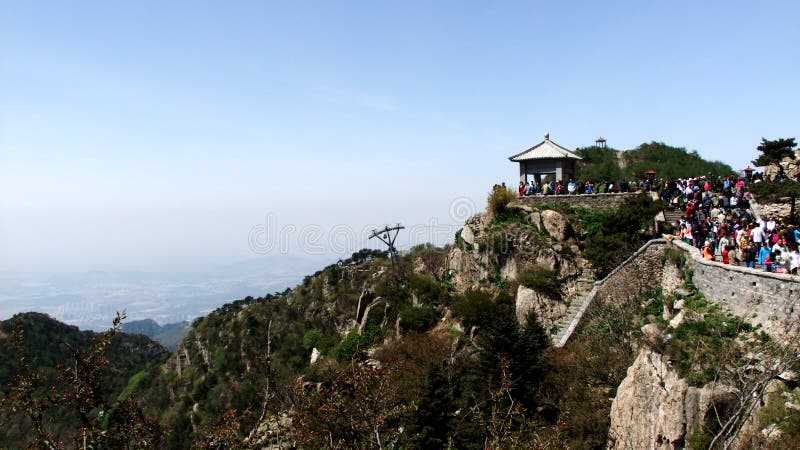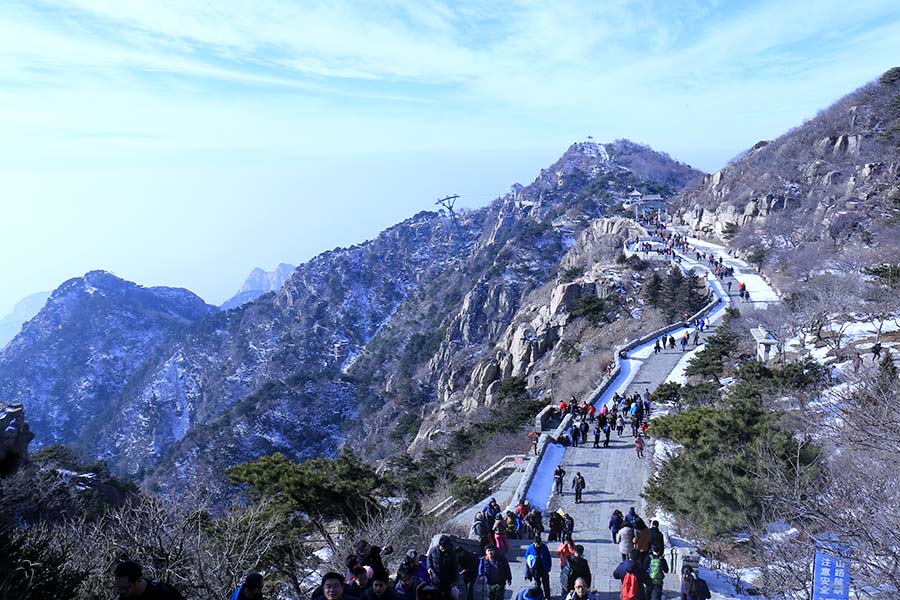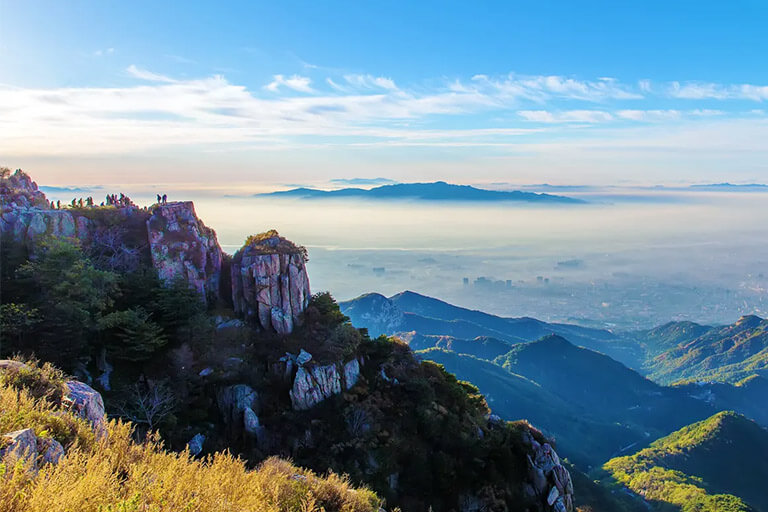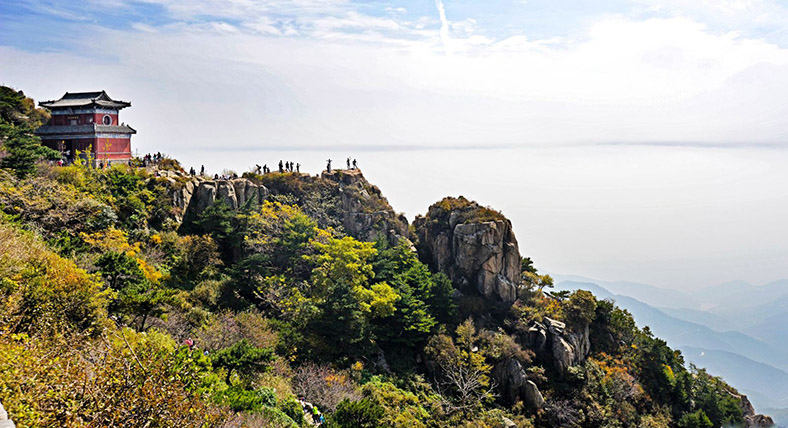The Spiritual Significance of Mount Tai: A Pilgrim’s Path to Enlightenment

An Essential Guide to Visiting Mount Tai
In This Guide
- An Essential Guide to Visiting Mount Tai
- The Rich History and Legends of Mount Tai
- Main Highlights: What You Absolutely Can’t Miss
- Planning Your Visit: A Practical Guide
- Tickets: Prices, Booking, and Tips
- How to Get There: A Complete Transportation Guide
- Local Cuisine and Accommodation Nearby
- Frequently Asked Questions
- Final Thoughts on Your Trip
Steeped in mystique and revered as one of China’s five sacred mountains, Mount Tai (泰山) offers more than just breathtaking views; it presents a tapestry woven from millennia of history, culture, and spirituality. Located in Shandong Province, this majestic peak has long served as a pilgrimage site for emperors, poets, and artists alike, all seeking to connect with the divine spirit that this revered landscape embodies.
As you embark on your journey to Mount Tai, you will find yourself traversing ancient stone steps—over 6,000 of them—each a testament to the countless souls who have made their way here in search of enlightenment and renewal. Along the ascent, the air is thick with the echoes of history, with temples, inscriptions, and pavilions dotting the trail, inviting you to pause and reflect on the stories they hold.

Mount Tai.
But fear not if you’re daunted by the climb; modern conveniences like cable cars can whisk you part of the way up, ensuring that visitors of all fitness levels can experience the majesty of this UNESCO World Heritage site. Whether you choose to hike under the soft glow of dawn to watch the sunrise sweep across the landscape or explore the intricate architecture of the Dai Temple at the summit, Mount Tai promises an unforgettable encounter with the heart of Chinese culture and spirituality.
Get ready to immerse yourself in serenity and splendor as you discover why Mount Tai is not just a mountain, but a sacred symbol of the enduring spirit of China.

Mount Tai.
The Rich History and Legends of Mount Tai
Mount Tai, known in Chinese as 泰山 (Tàishān), stands as a monumental symbol of Chinese history, spirituality, and culture. Located in Shandong Province, this majestic mountain has been a revered site for thousands of years, representing a confluence of natural beauty and human endeavor.
A Sacred Site Through the Ages
Mount Tai is one of the Five Sacred Mountains of China, and its historical significance dates back over 3,000 years. It has been a pilgrimage destination for emperors, scholars, and spiritual seekers alike. The mountain was traditionally viewed as a gateway between the heavens and earth, a belief reinforced by its towering peaks that seem to touch the sky. The first recorded ascent by an emperor was by Emperor Wu of the Han Dynasty in 110 B.C., marking the beginning of a long tradition of imperial worship and reverence.

Mount Tai.
Historical Significance
Throughout Chinese history, Mount Tai has been a site for numerous temples, altars, and stone inscriptions. Notable among these is the Dai Temple, a complex that showcases intricate architecture and is steeped in historical significance. This temple was built during the Han Dynasty and has undergone numerous renovations, serving as a spiritual hub for over two millennia. The temple complex is adorned with ancient inscriptions etched into stone, chronicling the visits of various emperors who sought blessings for their reigns.
In 1987, UNESCO recognized Mount Tai as a World Heritage Site, acknowledging its cultural significance and the exceptional beauty of its natural landscape. Visitors to the mountain can explore numerous ancient pathways, stone carvings, and religious sites, each telling a story of devotion and history.

Mount Tai.
Legends and Myths
Mount Tai is steeped in legends that add a mystical layer to its already rich history. One of the most famous legends involves the God of Mount Tai, known as Tian Zun. According to folklore, this deity would descend from the heavens to bless the mountain and its visitors. It is said that those who climb Mount Tai with pure intentions will receive blessings, health, and longevity.
Another prominent legend is linked to the famous Chinese philosopher Confucius, who is believed to have climbed the mountain to seek enlightenment. His teachings and thoughts reverberate through the ages, and Mount Tai remains a site of philosophical reflection and cultural significance.

Mount Tai.
Cultural Symbolism
The mountain is also a symbol of rebirth in Chinese culture, particularly as it marks the easternmost point of the Five Sacred Mountains. Its towering peaks and breathtaking vistas inspire awe and reverence, making it a popular destination for those seeking both spiritual fulfillment and a connection to nature.
Modern-Day Pilgrimage
Today, Mount Tai continues to attract millions of visitors annually, drawn not only by its historical and cultural significance but also by its stunning natural beauty. Adventurers can opt for the challenging hike up the mountain’s 6,000+ steps or take advantage of the cable cars that offer a quicker ascent. Regardless of the path chosen, the experience is both exhilarating and enriching, allowing travelers to walk in the footsteps of emperors and sages.

Mount Tai.
Conclusion
Mount Tai is not merely a mountain; it is a testament to the enduring spirit of Chinese civilization. The rich tapestry of history, legends, and cultural significance woven into its very fabric makes it an essential destination for those seeking to understand the depths of Chinese culture and spirituality. Whether you are a history enthusiast, a spiritual seeker, or an adventurer, Mount Tai offers a profound experience that resonates long after the journey concludes.
Main Highlights: What You Absolutely Can’t Miss
Discover the Unmatched Wonders of Mount Tai
Mount Tai, or Tai Shan, stands as a monumental symbol of Chinese culture and spirituality. As one of the Five Sacred Mountains of China, this majestic peak has attracted pilgrims, emperors, and travelers for centuries. Here’s a guide to the indispensable highlights that ensure your visit to Mount Tai is both enriching and unforgettable.

Mount Tai.
1. The Historic Dai Temple (岱庙)
At the base of the mountain lies the Dai Temple, a significant site that embodies the essence of Confucianism and Taoism. This expansive complex, with its stunning architecture and tranquil gardens, features numerous halls and pavilions dedicated to various deities. The Hall of the Heavenly Kings and the Emperor’s Tablet are must-see attractions within the temple, providing insight into the rich historical tapestry of the region.
2. The Ascent: Steps to the Summit
For the adventurous traveler, the ascent of Mount Tai is a rite of passage. With over 6,000 steps winding through the picturesque landscape, climbing to the summit is both a physical challenge and a spiritual journey. The views from the top are breathtaking, offering a panoramic vista of the surrounding countryside that is especially stunning at sunrise. Make sure to bring a camera to capture the moment!
3. Cable Car Experience
If you prefer a more leisurely approach, the cable car ride offers a convenient alternative to the strenuous climb. This exhilarating journey transports you partway up the mountain, allowing you to enjoy sweeping views without the exhaustive trek. It’s an excellent option for families or those seeking a more relaxed way to experience Mount Tai’s beauty.

Mount Tai.
4. The Summit: Tianzhu Peak (天柱峰)
Upon reaching the summit, you will stand at Tianzhu Peak, the highest point of Mount Tai. Here, the air is crisp, and the serenity is palpable. Take time to savor the expansive views and visit the Pavilion of the Heavenly Monarch, which offers a perfect vantage point for photography and reflection. The summit is also a fitting place to contemplate the significance of this sacred site.
5. Bixia Temple (碧霞祠)
As you make your way down, don’t miss the Bixia Temple, dedicated to the goddess of Mount Tai. Nestled amidst lush greenery, this temple is revered by pilgrims and features intricate carvings and ancient inscriptions. The serene atmosphere makes it a perfect spot to rest and absorb the spiritual energy of the mountain.

Mount Tai.
6. Cultural Festivals and Events
If your visit coincides with the Tai Mountain Cultural Festival, you’ll witness a vibrant display of traditional performances, including music, dance, and theatrical reenactments of historical events. These festivities bring the history of Mount Tai to life, offering a deeper understanding of its cultural significance.
7. Natural Wonders
Aside from its historical and spiritual allure, Mount Tai boasts stunning natural beauty. As you hike or take the cable car, you’ll encounter beautiful granite cliffs, cascading waterfalls, and diverse flora. Take the time to explore Taohuayu Canyon and Yueguan Peak, both of which offer picturesque landscapes and hiking opportunities.

Mount Tai.
8. Local Cuisine
Don’t leave Mount Tai without indulging in local delicacies! The region is known for its Tai’an beef, a tender, flavorful dish that is best enjoyed at one of the many local restaurants near the mountain. Pair your meal with a cup of Tai Mountain tea for an authentic experience.
Final Thoughts
Mount Tai is not just a mountain; it is a living testament to China’s rich history and cultural depth. Whether you choose to hike the ancient steps or glide up in a cable car, the experiences awaiting you at this sacred site will undoubtedly leave an indelible mark on your journey through China. Prepare to be inspired by the breathtaking views, profound history, and the spiritual energy that envelops this iconic peak.
Planning Your Visit: A Practical Guide
Essential Information for Your Journey to Mount Tai
Embarking on a journey to Mount Tai, one of China’s five sacred mountains, is an adventure steeped in history, culture, and breathtaking natural beauty. As you plan your visit, here’s everything you need to know to make your experience memorable.

Mount Tai.
Getting There
Location:
Mount Tai is located in Tai’an, Shandong Province, China. The address for the main entrance is Hongmen Road, Taishan District, Tai’an 271000, China.
Transportation Options:
– By Train: High-speed trains frequently run from major cities such as Beijing, Jinan, and Shanghai to Tai’an. The Tai’an Railway Station is conveniently located near the city center.
– By Bus: Local buses connect the train station to the foot of Mount Tai.
– By Taxi: Taxis are readily available and offer a direct route to the mountain entrance.

Mount Tai.
Best Time to Visit
The ideal time to visit Mount Tai is during the spring (April to June) and autumn (September to November). The weather during these months is mild, and the scenery is particularly stunning, with vibrant foliage and clear skies.
Opening Hours
Mount Tai is open year-round, 24 hours a day, but the best time to begin your ascent is between 5:00 AM to 11:00 PM. This allows you to avoid crowds and enjoy the sunrise or sunset from the summit.
Entrance Fees
The entrance fee varies depending on the season and the specific routes you choose (hiking vs. cable car). It is advisable to check the official website or local tourist information for the latest pricing and any special offers.
Routes to the Summit
Hiking:
– The traditional route consists of over 6,000 steps and a climb of approximately 1,400 meters in altitude. This path is a pilgrimage route that has been traversed by emperors and pilgrims for centuries.
– Tip: Start early to avoid the crowds and bring plenty of water and snacks.
Cable Car:
– For those who prefer a more leisurely ascent, a cable car is available that takes you partway up the mountain. This option is ideal for families or travelers with limited mobility.
Must-See Attractions
Once you reach the summit, be sure to explore the historical and cultural sites, including:
– Dai Temple: A grand temple complex known for its intricate architecture and historical significance.
– Bixia Temple: A beautiful site that offers stunning views of the surrounding landscape.
– Sunrise Viewing Points: Witnessing the sunrise from the mountain is a breathtaking experience that many travelers cherish.
Recommended Tours
If you prefer a guided experience, consider booking one of the following tours:
– Private Day Tour from Tai’an: Includes lunch and a cable car ride.
– 2-Day Tour from Beijing: Visit both Mount Tai and Qufu, the hometown of Confucius.
Tips for a Successful Visit
- Dress Appropriately: Wear comfortable hiking shoes and dress in layers, as temperatures can vary significantly.
- Stay Hydrated: Bring a refillable water bottle and plenty of snacks to keep your energy up during your climb.
- Respect the Environment: As a UNESCO World Heritage site, it is crucial to preserve the natural beauty of Mount Tai by following local guidelines and disposing of waste properly.
- Be Prepared for Crowds: Weekends and holidays can be particularly busy, so plan your visit during the week if possible.
Nearby Attractions
While you’re in Tai’an, consider exploring additional nearby attractions:
– Taohuayu Canyon: Known for its stunning landscapes and hiking opportunities.
– Yueguan Peak: Offers a beautiful vantage point of the surrounding area.
– Daimiao Temple: An ancient site rich in cultural heritage.
With this practical guide, you’re well-equipped to enjoy a meaningful and enriching visit to Mount Tai. Whether you choose to hike, take the cable car, or simply soak in the majestic views, Mount Tai promises an unforgettable experience steeped in history and spirituality.
Tickets: Prices, Booking, and Tips
Essential Information for Visiting Mount Tai
Visiting Mount Tai, a UNESCO World Heritage site and one of China’s five sacred mountains, is an awe-inspiring experience steeped in cultural and historical significance. To make the most of your journey, understanding the ticketing process, pricing, and booking tips is essential.
Ticket Prices
- General Admission: The entrance fee to Mount Tai is approximately ¥150 (Chinese Yuan) for adults. This grants you access to the scenic areas and hiking trails.
- Cable Car Tickets: For those looking to minimize the physical exertion, cable car rides are available at two different stations:
- Yuhuang Peak Cable Car: Approximately ¥100 one way, ¥200 round trip.
- Taishan Cable Car: Approximately ¥80 one way, ¥160 round trip.
Booking Tips
- Purchase in Advance: While tickets can be bought at the entrance, it is advisable to purchase them online or through travel agencies to avoid long queues, especially during peak travel seasons.
- Consider Guided Tours: Several tour operators offer packages that include transportation, meals, and guided experiences. Prices for these tours typically start around ¥288 (approximately $40) and can include amenities like lunch and cable car rides.
- Off-Peak Visits: To fully enjoy the breathtaking scenery and avoid the crowds, consider visiting during weekdays or early in the morning.
Additional Considerations
- Operational Hours: Mount Tai is open 24 hours a day, but cable car services may have specific operating hours. Be sure to check the latest schedules.
- Accessibility for All: For travelers with varying fitness levels, Mount Tai offers a range of options from hiking the over 6,000 steps to utilizing the cable cars. Choose the route that best suits your abilities.
- Weather Preparedness: The weather can change rapidly on the mountain, so it’s wise to dress in layers and be prepared for both sun and rain.
Nearby Attractions
While planning your visit, consider exploring nearby sites such as:
– Dai Temple: A significant historical site located at the foot of Mount Tai.
– Bixia Temple: Situated on the mountain, this temple is a beautiful spot for visitors to take in the scenery and enjoy the spiritual atmosphere.
With its stunning vistas, rich history, and cultural significance, Mount Tai promises an unforgettable adventure for international travelers interested in Chinese history and culture. Plan ahead and immerse yourself in the beauty of this sacred site!
How to Get There: A Complete Transportation Guide
Navigating Your Way to Mount Tai: A Traveler’s Transportation Guide
Mount Tai, or Tai Shan (泰山), stands as one of China’s most iconic and sacred mountains, steeped in history and cultural significance. Known as a pilgrimage site for emperors and a UNESCO World Heritage Site, it’s essential for international travelers to know how to reach this magnificent destination. Here’s a comprehensive guide to help you navigate your journey to Mount Tai.
Getting to Tai’an
Mount Tai is located in Tai’an, Shandong Province. The first step in your journey is to reach Tai’an itself. Here are the best transportation options:
By Air
- Nearest Airport: The closest major airport is Jinan Yaoqiang International Airport (TNA), located approximately 100 kilometers (62 miles) away from Tai’an.
- Transportation from the Airport:
- Train: Take the airport shuttle to Jinan Railway Station. From there, catch a high-speed train to Tai’an, which takes about 30-40 minutes.
- Taxi: Direct taxis are available from the airport to Tai’an, taking about 1.5 to 2 hours, depending on traffic.
By Train
- High-Speed Rail: Tai’an is well-connected through China’s extensive high-speed rail network. Major cities like Beijing, Shanghai, and Jinan frequently have trains to Tai’an.
- Beijing to Tai’an: Approximately 2 hours via high-speed train.
- Shanghai to Tai’an: Approximately 4-5 hours.
- Tai’an Railway Station: Once you arrive at Tai’an Railway Station, you can easily access local transportation options to the mountain.
Local Transportation Options
Once you arrive in Tai’an, getting to Mount Tai is straightforward:
Taxi Services
- Taxis are readily available and can take you directly to the entrance of Mount Tai. Be sure to have the destination written in Chinese (泰山) for ease of communication.
Public Buses
- Bus Services: There are frequent buses from Tai’an city center to the base of Mount Tai. Look for buses labeled for “Mount Tai” or “Tai Shan.”
- Cost: Public bus fares are very affordable, typically costing around 2-5 RMB.
Reaching the Mountain Entrance
Mount Tai has multiple entrances, but the most popular are the North Gate and the South Gate. Here’s what you need to know:
- North Gate: This is the primary access point for those who wish to hike the traditional stairway route. It is also the starting point for those who want to experience the pilgrimage path.
- South Gate: This entrance is more accessible for tourists who prefer a smoother ascent using public transport options like buses and cable cars.
Exploring Mount Tai
Hiking vs. Cable Car
- Hiking: For the adventurous, the hike up Mount Tai involves over 6,000 steps and is a rewarding experience. The classic route is approximately 10 kilometers and offers breathtaking views along the way.
- Cable Car: To save time and energy, consider taking a cable car partway up the mountain. The cable car station is easily accessible from the South Gate. This option allows travelers of varying fitness levels to enjoy the stunning scenery without the strenuous climb.
Timings and Tips
- Opening Hours: Mount Tai is open year-round, 24 hours a day. However, the best time for hiking is from 5 AM to 11 PM.
- Plan Ahead: Due to its popularity, especially during holidays, consider visiting during weekdays or early in the morning to avoid crowds.
- What to Bring: Wear comfortable walking shoes, bring water, and pack snacks. The weather can change quickly, so layers are recommended.
Final Thoughts
Your journey to Mount Tai promises to be as memorable as the destination itself. By planning your transportation with these options in mind, you can focus more on soaking in the spiritual atmosphere and stunning landscapes of this revered site. Whether you choose to hike the ancient steps or glide up in a cable car, Mount Tai is sure to leave an indelible mark on your travel experience.
Local Cuisine and Accommodation Nearby
Discovering Local Flavors and Comfort Near Mount Tai
Visiting Mount Tai (泰山) is not just about soaking in the breathtaking views and the rich cultural heritage; it’s also an opportunity to indulge in the delectable local cuisine and enjoy comfortable accommodations. Here’s a guide to help you savor the essence of Tai’an, the city that serves as the gateway to this majestic mountain.
Local Cuisine to Savor
1. Tai’an Imperial Cuisine (泰安宫廷菜)
This local gastronomic style is a treasure trove of flavors, deeply rooted in Shandong culinary traditions. Visitors should not miss trying the braised seafood, particularly the sea cucumber, which is a delicacy often served in high-end restaurants.
2. Jinan-style Dumplings (饺子)
Just a short trip from Tai’an, Jinan’s famous dumplings are a must-try. These handmade delights can be found in many local restaurants. Opt for the pork and cabbage dumplings for an authentic experience, or try the soup dumplings that burst with flavor.
3. Tai’an Grilled Fish (烤鱼)
After a long day of hiking, enjoy a leisurely meal of grilled fish. Many local eateries along the streets serve this dish, often marinated with spices and served with a variety of dipping sauces.
4. Stir-Fried Vegetables (炒菜)
The region is known for its fresh produce. Look for dishes featuring seasonal vegetables, often lightly stir-fried, allowing the natural flavors to shine.
5. Traditional Tea (中国茶)
Wrap up your culinary experience with a cup of Chinese tea. Visit a local teahouse to enjoy a tea ceremony, where you can taste different brews, including the fragrant Jasmine tea or the robust Pu’er.
Recommended Accommodations
1. Tai’an Grand Hotel (泰安大酒店)
Located conveniently near the base of Mount Tai, this hotel offers modern amenities with traditional Chinese decor. It’s an ideal choice for travelers seeking comfort after a day of exploration. The hotel features an on-site restaurant that serves both local and international dishes.
2. Shandong Tianyu Hotel (山东天宇酒店)
This hotel is known for its excellent service and clean, comfortable rooms. It’s a great base for those looking to explore the area. Don’t forget to visit their breakfast buffet for a variety of local delicacies.
3. Mount Tai International Hotel (泰山国际酒店)
This upscale hotel provides stunning views of Mount Tai and is equipped with a fitness center, spa, and a rooftop restaurant. Guests can enjoy traditional Shandong meals while taking in the spectacular scenery.
4. Tai’an Youth Hostel (泰安青年旅舍)
For budget-conscious travelers, this hostel offers a friendly atmosphere and is situated close to the mountain’s main entrance. It’s an excellent option for backpackers who want to meet fellow travelers while enjoying affordable rates.
5. Zhanlu Hotel (瞻鲁酒店)
A modern hotel that blends comfort with convenience, Zhanlu is situated near major attractions. The staff is known for their hospitality, making it a welcoming place to unwind.
Conclusion
When visiting Mount Tai, the journey is as much about the experiences you gather in the city of Tai’an as it is about the mountain itself. From indulging in local culinary delights to resting in comfortable accommodations, your trip promises to be a memorable exploration of Chinese history and culture. Enjoy every moment as you create lasting memories in this remarkable region!
Frequently Asked Questions
Frequently Asked Questions
1. What is Mount Tai known for?
Mount Tai (泰山) is one of China’s Five Sacred Mountains and holds significant cultural and historical importance. It has been a site for imperial sacrifices and pilgrimage for over 3,000 years, symbolizing the spirit of China. The mountain is adorned with ancient temples, inscriptions, and stunning natural beauty, making it a UNESCO World Heritage Site.
2. What are the best times to visit Mount Tai?
The best times to visit Mount Tai are during spring (April to June) and autumn (September to October). These seasons offer mild weather, stunning foliage, and vibrant landscapes. Summer can be hot and crowded, while winter may bring snow, making some paths difficult to navigate.
3. How do I get to Mount Tai?
The nearest major city is Tai’an, which is well-connected by train and bus services. From Tai’an, you can take a taxi or local bus to the mountain’s entrance. High-speed trains also connect Tai’an with major cities like Beijing and Jinan, providing convenient travel options.
4. Can I hike up Mount Tai?
Yes, you can hike up Mount Tai! The classic route features over 6,000 stone steps leading to the summit. The hike is challenging but rewarding, with breathtaking views along the way. For those preferring a gentler ascent, there are cable cars available that can take you partway up the mountain.
5. Are there facilities for visitors at the summit?
At the summit, you will find several facilities, including rest areas, shops, and the grand Dai Temple complex. The temple is a significant historical site worth exploring, showcasing intricate architecture and cultural artifacts.
6. What should I prepare for my visit?
Visitors should wear comfortable hiking shoes, bring water, and pack light snacks. It’s advisable to start early in the day to avoid crowds and to allow ample time for the hike or cable car ride. A camera is essential to capture the stunning views!
7. Is there an entrance fee to Mount Tai?
Yes, there is an entrance fee to Mount Tai, which varies depending on the season and whether you choose to use the cable car. It’s best to check the official website or local tourism information for the most current pricing details.
8. Are there guided tours available?
Absolutely! Many guided tours are available, ranging from day trips to more extensive packages that include meals and transportation. These tours often provide valuable insights into the history and cultural significance of the area, making your visit even more enriching.
Final Thoughts on Your Trip
As your journey to Mount Tai draws to a close, you’ll find that the experiences you’ve gathered transcend mere sightseeing. This sacred mountain, steeped in history and culture, is not just a destination; it’s a pilgrimage into the heart of Chinese spirituality and tradition.
Embrace the Spirit of the Mountain
Standing atop Mount Tai, surrounded by breathtaking vistas that stretch to the horizon, it’s easy to understand why this mountain has been revered for centuries. Here are a few reflections to take with you:
-
Historical Significance: From emperors to common pilgrims, Mount Tai has welcomed those seeking enlightenment and a deeper connection with nature. The temples and inscriptions you encountered serve as a testament to its enduring legacy.
-
Cultural Richness: The intricate architecture, the rituals observed, and the tales of the mountain all weave a rich tapestry of Chinese history. Perhaps you even participated in a moment of reflection at one of the many temples, feeling the weight of centuries of reverence.
-
Natural Beauty: The journey itself, whether on foot or via the cable car, offers an intimate encounter with nature, showcasing dramatic cliffs, lush greenery, and serene landscapes. Each step or cable ride brings you closer to the majesty of the world around you.
A Journey Worth Taking
As you prepare to leave, consider how Mount Tai has not only challenged you physically but has also enriched your understanding of Chinese culture. It is an experience that lingers in the heart long after you descend. Whether you hiked the 6,000+ steps or opted for a more leisurely ascent, the mountain’s spirit has surely left an indelible mark on your soul.
Take Your Memories Home
In closing, remember that Mount Tai is more than just a climb; it is a journey into the essence of what it means to be human. Carry with you the stories, the tranquility, and the awe of this sacred space. Let it inspire your own life’s path as you share your experiences and insights with others.
Your adventure may end here, but the spirit of Mount Tai will travel with you, encouraging you to explore, appreciate, and connect with the world around you in profound ways. Safe travels!